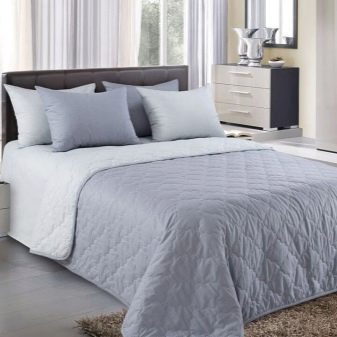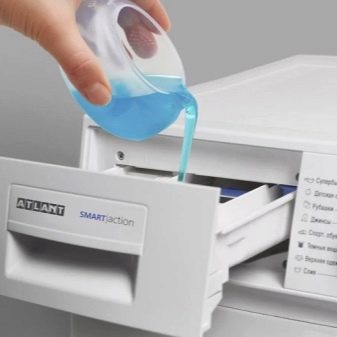Choosing a quilted bedspread
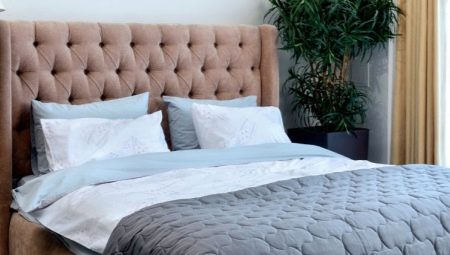
A properly chosen bedspread will help to give the bed a neat appearance. Among the huge variety of such products, quilted models are especially in demand. They are made from 2 sewn fabrics, between which a layer of insulation is provided.
Such bed covers are thin summer, thick insulated, plain light, dark or bright, with prints. Different materials are used for their sewing - the appearance of the bedspread, its operational properties and durability will depend on them.
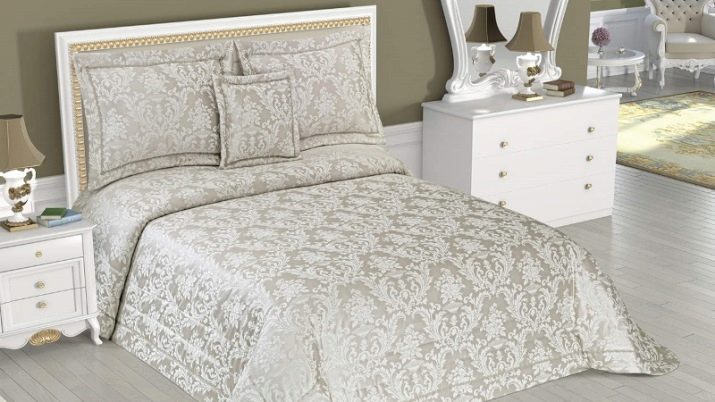
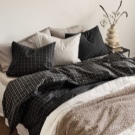
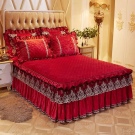
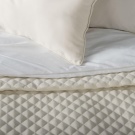
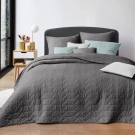
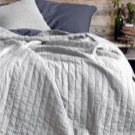
Peculiarities
A quilted bedspread can create an atmosphere of comfort and warmth in the bedroom. It is suitable for both beds and sofas. Thanks to the stitching of the materials, the filler is securely fixed between 2 layers of fabric, it does not get confused both during operation and during washing. There are different stitches: parallel, perpendicular or curly, but intersecting stitches are considered optimal sewing.
All types of quilted capes have the following advantages:
- allow bed linen to stay fresh for a long time, since the bedspreads prevent dust from entering;
- hide the sharp corners of the bed, mask various external defects of the bed frame;
- make the room more aesthetic and attractive, can become an original interior decoration;
- give a pleasant tactile sensation.
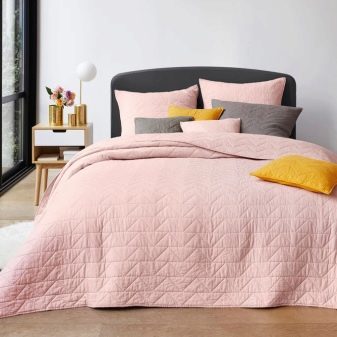

The bedspreads are functional - they can be used not only as a cover for a bed or sofa, but also as a blanket. Quilted bedspreads keep their shape perfectly, practically do not wrinkle, are durable and practical.
They can be machine washed on a delicate cycle. The disadvantages of some types of capes include the ability to accumulate static electricity, as well as the high price of luxury products made from expensive natural fabrics.
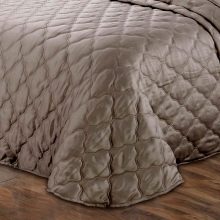
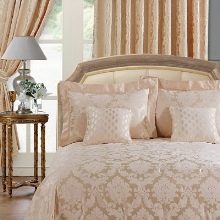
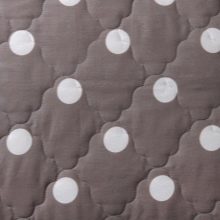
Materials (edit)
Different materials are used for the production of quilted bedspreads, this applies not only to the upper layers, but also to the insulation. Synthetic raw materials are most often used as a filler, for example, synthetic winterizer, artificial swan's down, holofiber and other options. Capes based on them combine lightness, warmth and unpretentious care. For warm winter models also use wool - it has an excellent heating effect, absorbs excess moisture well.
When sewing thin summer models, it can be used as a filler natural silk, bamboo or eucalyptus fiber. In the manufacture of quilted bedspreads, cotton, jacquard, satin and other fabrics are used. All of them have certain features and performance characteristics.
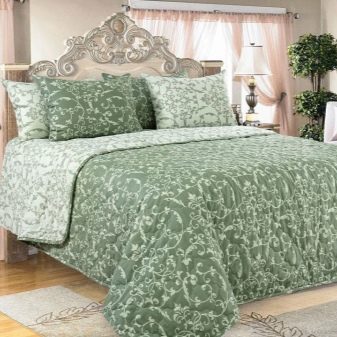
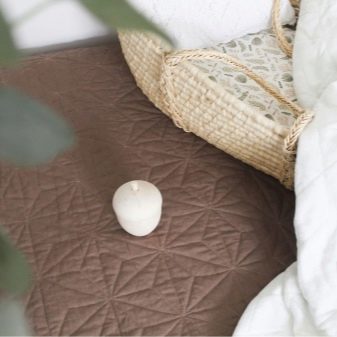
Cotton
Cotton attracts buyers for many reasons. Such raw materials are natural, they are environmentally friendly and are hypoallergenic.... Cotton bedding is suitable even for babies. Cotton bedspreads are unpretentious to care for, they are easy to wash and dry quickly. Another significant advantage is its good wear resistance.
Cotton capes are affordable, which is why they are in high demand. They are also pleasant to the touch and breathable. The disadvantages of cotton include fading (with frequent washing), fading when exposed to direct sunlight. In addition, cotton products shrink - this feature must be taken into account when choosing the size of the bedspread.
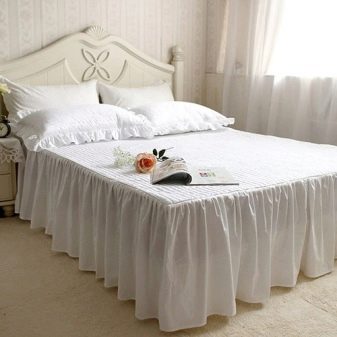

Calico
Natural durable material that retains its dimensions, original colors and images even after hundreds of washes... Calico dries quickly, but wrinkles, so after washing it will have to be ironed. This fabric is pleasant to the touch, it allows air to pass through well, thanks to which the body will be able to "breathe".
Possesses hygroscopicity, thanks to which it removes excess moisture. A bonus to these advantages is the affordable cost of coarse calico bedding. The disadvantages of this natural fabric are the lack of shine, as well as the formation of pellets on the surface after prolonged use.
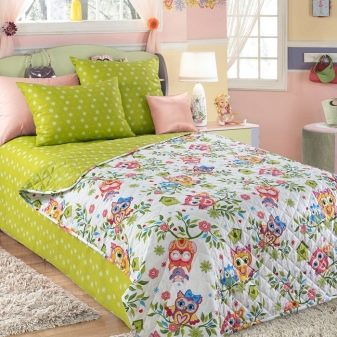
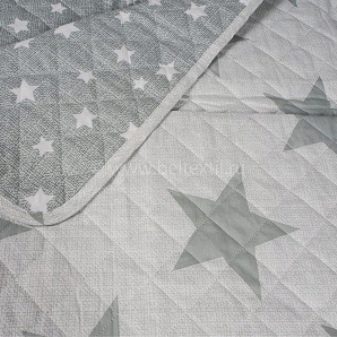
Satin
Strength and durability are the main advantages of satin bedspreads. These beddings are elegant and luxurious, and they look expensive thanks to the slight sheen. Satin capes can withstand up to 300 washes and at the same time retain their shape and richness of colors. The fabric has good tear and abrasion resistance and good air circulation.
The material removes excess moisture, due to which it will not be hot under the satin blanket in the summer heat. In addition, the products do not cause allergies and are suitable for people with sensitive skin types, prone to irritation. Among the disadvantages of high-quality satin bedspreads, buyers note the high cost.
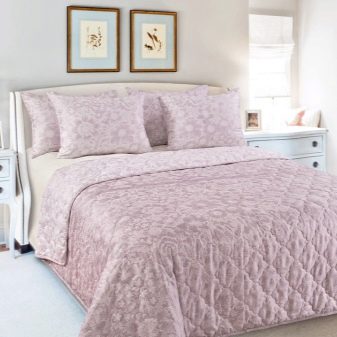
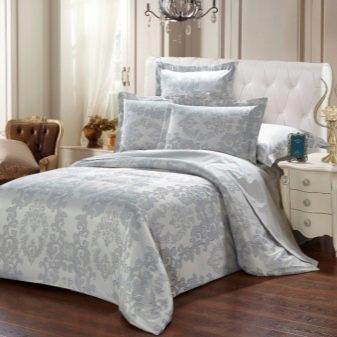
Atlas
It is a fabric with a smooth surface and a pronounced shine. Quilted satin bedspreads have high decorativeness, thanks to which they are in demand among domestic buyers. Benefits of satin capes:
- pronounced dust-repellent properties;
- hypoallergenic;
- the ability to remove excess moisture;
- good breathability;
- antistatic effect;
- wear resistance;
- the possibility of draping.
The disadvantages of products include possible shrinkage during washing at high temperatures, the impossibility of "repairing" the canvas in case of damage (due to the flowability of the satin), the ability to stretch in length and width.
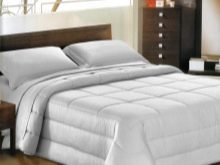


Velvet
Velvet canvases are very beautiful they are pleasant to the touch due to their softness and silkiness... The material has a dense texture, it is hygroscopic, air permeable, does not electrify and does not shrink after washing.The disadvantages include high cost, capriciousness in care, a tendency to dust settling.
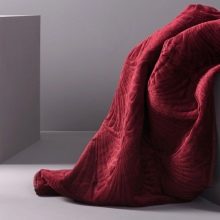
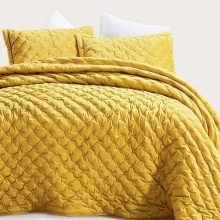
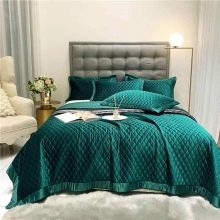
Linen
Natural material that is different hygroscopicity, resistance to dirt, increased wear resistance. The fabric is pleasant to the touch, keeps its shape well. The disadvantages of linen include high cost.
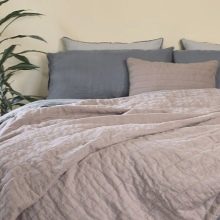
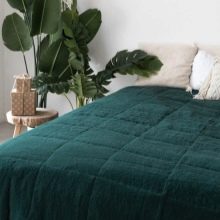

Silk
Silk textiles look luxurious thanks to their delicate sheen. Due to this feature, a silk bedspread can become the main accent in the interior of a bedroom. Its other positive qualities include antibacterial properties, hypoallergenicity. The main disadvantages are the high price and a small selection of silk bedspreads.
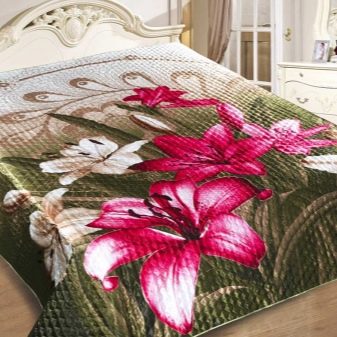
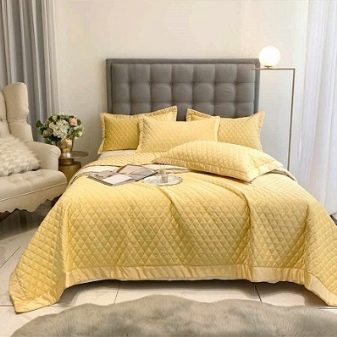
Jacquard
Capes made of this material durable, resistant to stretching and shrinkage after washing... The material is practical and easy to clean, it practically does not wrinkle. Jacquard is distinguished by its reliability and durability, aesthetics. The disadvantages of jacquard canvases include their high cost, especially when it comes to models of design work.
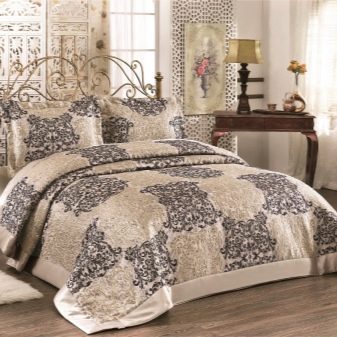
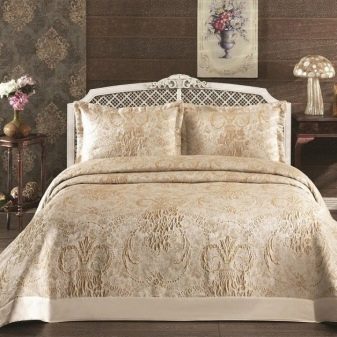
Velours
Velor fabrics reliable, strong and durable. They look beautiful due to the velvety surface with soft pile. Velor covers are pleasant to the touch, but demanding to care for.
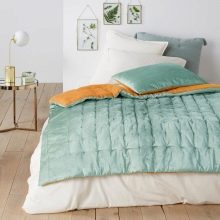
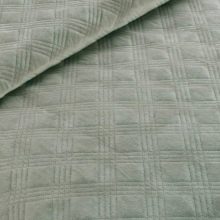

Other
Bedspreads can also be sewn from:
- percale;
- acrylic;
- fur;
- jeans.
Microfiber is another popular material. It is resistant to wear, does not wrinkle, is breathable, dries quickly.
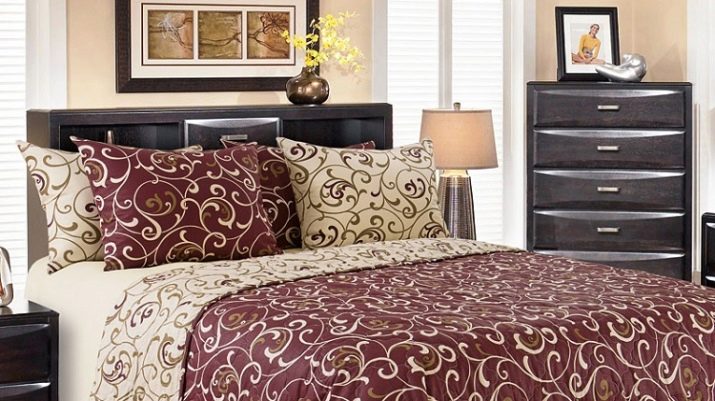
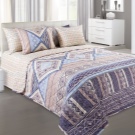
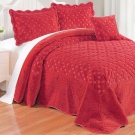

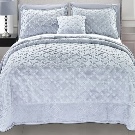
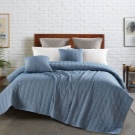
Dimensions (edit)
Bed covers are produced in different size ranges, due to which you can purchase a suitable size product for a bed of various sizes. In order not to make a mistake, you need to make preliminary measurements and add about 20 cm to the "allowances" on each side. For example:
- bedspreads 140x200, 140x210 cm are suitable for a single bed;
- for a 1.5-bed room - 150x200, 150x210, 150x220 cm (with a one-and-a-half model without a back, you can take more overall options);
- for double rooms - 180x220, 180x220, 175x205 cm;
- for Euro beds, the sizes of the capes are 200x220, 200x240, 215x240 cm;
- for Euromaxi - 220x240, 240x240, 260x260 cm.

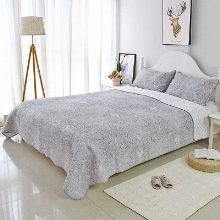

Design
The design performance of bed covers can be varied. The canvas can be monochromatic, with a pattern or embroidery. Single-color products are easier to fit into the interior of the bedroom. For example, a black or white bedspread is perfect for minimalism. Beige linen, products in soft cream or pastel colors will look good in rooms decorated in classic styles. The following shades of bedspreads are popular: blue, blue, burgundy, brown, lilac, red. And also models in a nautical style and in a patchwork style (a surface "paved" with squares) are in demand.
Decorative capes with ruffles around the edges look especially luxurious. Such bedspreads must be selected in strict accordance with the size of the bed, otherwise the ruffles will hang down ugly. Double-sided quilted bedspreads are of particular value: their sides are made of fabrics of different colors or with different prints. Thanks to these solutions, you can quickly and easily change the decor of the bed without buying a new cape.
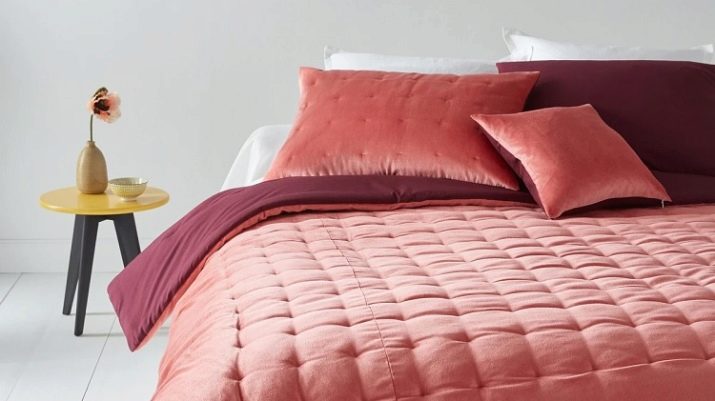
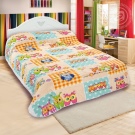
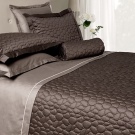
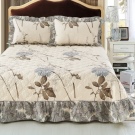
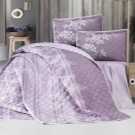
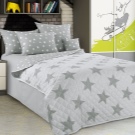
How to choose?
When buying a quilted bedspread, there are a number of parameters to consider.
- Appointment... It is important to decide whether the cape will perform only a decorative function or be used as a blanket. In the second case, preference should be given to products with dense non-slip material and warm filler.
- Material... The canvases must be selected in accordance with your requirements. For example, flax is considered resistant to dirt, bed mites will not settle in bamboo fiber, and wool is famous for its healing properties.
- The size beds.
- Bedroom style... Plaid should be in harmony in color with other decor and interior items.
- Price... You should not give preference to the cheapest models - most likely, this is a low quality product that will quickly lose its presentation.
It is necessary to take into account for whom the coverlet is purchased: for example, for a girl it is advisable to choose delicate models of light colors, products with bright colors and prints. There are many teenage capes on sale: they differ in the type of stitch, colors, and can have realistic 3D prints.
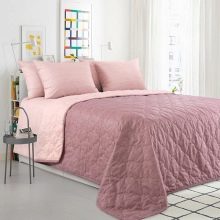
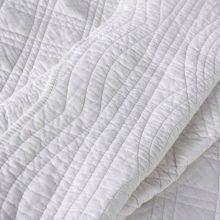
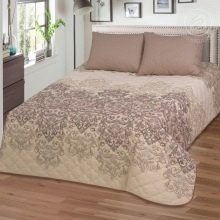
How to care?
Different materials require different care. In order not to spoil the appearance of the canvas, you need to familiarize yourself with the characteristics of the fabric and the rules for caring for it. There are also several guidelines that work for most types of quilted bedspreads:
- do not use aggressive bleaches;
- do not soak the quilted fabrics - this can lead to a deterioration in the properties of the insulating layer;
- you need to wash products on a delicate mode, and wring out - at the lowest speeds;
- it is recommended not to allow coarse mechanical drying.
If the rules of care and operation are not followed, the durability of the product can be greatly reduced. That is why it is important to follow all the manufacturer's recommendations for the care of quilted capes.
